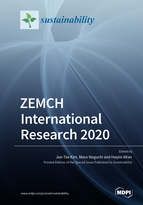ZEMCH International Research 2020
A special issue of Sustainability (ISSN 2071-1050).
Deadline for manuscript submissions: closed (31 May 2021) | Viewed by 44030
Special Issue Editors
Interests: photovoltaic/thermal (PV/T); building-integrated PV/T (BIPVT); zero energy buildings; vaccuum insulation panel (VIP)
Special Issues, Collections and Topics in MDPI journals
Interests: ZEMCH Network; zero energy mass customized housing design engineering; environmental experience design analysis; mass personalization; machine learning; value analysis; vertical subdivision plug-in housing system
Special Issues, Collections and Topics in MDPI journals
Interests: building performance and simulation; indoor environmental quality; passive design; sustainable architecture; architectural engineering; urban regeneration; building information modelling; healthy buildings
Special Issues, Collections and Topics in MDPI journals
Special Issue Information
Dear Colleagues,
The 7th edition of the Zero Energy Mass Custom Home (ZEMCH) International Conference (http://www.zemch2019seoul.org/) was held in Seoul, Republic of Korea from 26th–28th November 2019.
ZEMCH is the acronym of “Zero Energy Mass Custom Home” and this research network was established with the aim of encouraging the active participation of academic researchers, , policy makers, and industry stakeholders, tackling issues arising in the delivery of socially, economically, environmentally and humanly sustainable built environments in developed and developing countries. Essentially, homes need to be designed and operated in such a way that helps to secure or improve physical and mental health and wellbeing of the occupants with diverse socio-economic backgrounds and cultural differences. Moreover, housing is also a complex system of energy and environment. Subsequently, energy use in buildings tends to generate negative impacts on environmental consequences and, thus, it cannot be undermined. Gradually, house-builders and housing manufacturers are becoming more aware of, and responsive to, the necessity for delivering zero energy/emission mass custom homes (i.e., ZEMCH) that contribute to alleviating the negative environmental impacts of climate change, while accommodating individual needs and demands of housing.
This Special Issue is titled “ZEMCH International Research 2020”, reflecting the outcomes of the ZEMCH International Conference 2019, and aims to address innovative developments, state-of-the-art technologies and ideas in areas related to design, production and marketing issuessurrounding the ZEMCH delivery and operation around the globe.
Selected authors from the ZEMCH 2019 conference are invited to submit their adapted papers to this Special Issue. Moreover, we also encourage researchers who were unable to participate in the 2019 conference to submit their research outcomes to this edition, which will be fully peer-reviewed, with the view to further selection and publication.
Prof. Dr. Jun-Tae Kim
Prof. Dr. Masa Noguchi
Prof. Dr. Haşim Altan
Guest Editors
Manuscript Submission Information
Manuscripts should be submitted online at www.mdpi.com by registering and logging in to this website. Once you are registered, click here to go to the submission form. Manuscripts can be submitted until the deadline. All submissions that pass pre-check are peer-reviewed. Accepted papers will be published continuously in the journal (as soon as accepted) and will be listed together on the special issue website. Research articles, review articles as well as short communications are invited. For planned papers, a title and short abstract (about 100 words) can be sent to the Editorial Office for announcement on this website.
Submitted manuscripts should not have been published previously, nor be under consideration for publication elsewhere (except conference proceedings papers). All manuscripts are thoroughly refereed through a single-blind peer-review process. A guide for authors and other relevant information for submission of manuscripts is available on the Instructions for Authors page. Sustainability is an international peer-reviewed open access semimonthly journal published by MDPI.
Please visit the Instructions for Authors page before submitting a manuscript. The Article Processing Charge (APC) for publication in this open access journal is 2400 CHF (Swiss Francs). Submitted papers should be well formatted and use good English. Authors may use MDPI's English editing service prior to publication or during author revisions.
Keywords
- Energy Efficiency in Buildings
- Environmental Sustainability Policy and Economy
- Building Performance Evaluation/Simulation
- Sustainable Urban Regeneration
- Prefabrication and IT
- Low/Zero Energy Affordable Housing and Construction
- User Behaviour and BIM
- Environmental Experience Design
- Design Data Analytics
- Renewable Energy and Technology
- Mass Customisation and Personalisation
- Sustainable Housing Development
- Inclusive Design for Ageing and Diversity
- Humanitarian Design and Engineering








